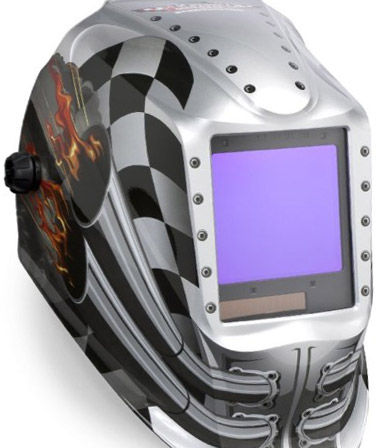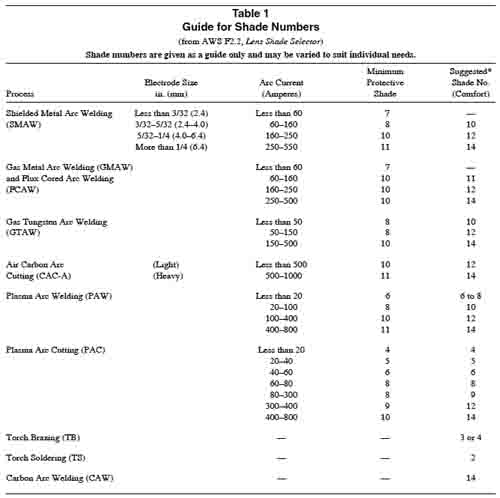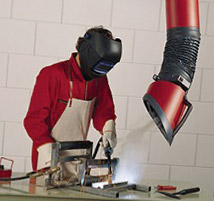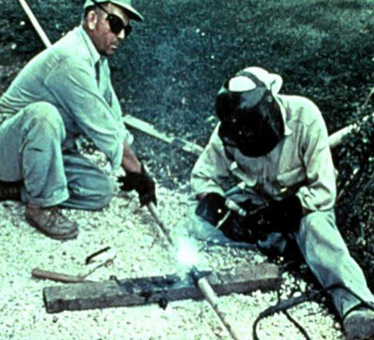When working with arc welding equipment safety precautions involve planning for protection from the following:
- Electrical shock: Shock and exposure to the process requires precautions. Electric shocks can result in explosions, fire and even death. When working on electrical conductive materials, stand on an insulating mat.
- Personal Protection Equipment: Safety includes shielding the skin from burns and electrical exposure, equipment maintenance and preparation for accidents and injuries.
- Explosions and Fire: due to exposure from sparks and molten metals.
- Ventilation and Fumes: refers to compounds in materials such as stainless steel that are dangerous at levels above those recommended by OSHA.
- Noise
- Burn Risk: from hot objects and metal splatter
Every welding tool and all materials are labeled with arc welding safety guidelines. These are available on what is called a MSDS sheet (check website of manufacturer). Each MSDS will contain information on:
- Hazards
- Safe use
- Handling instructions
- How to contact the manufacturer
- Composition and identity
All equipment should comply with NEMA (National Electronic Manufacturers Association) or Underwriters Laboratories (UL) standards.
Personal Protection Equipment
These are the essential parts of arc welding safety protection gear:
- Welding Jacket: Welding jackets that are flame retardant protect against burn and other injuries associated with electric arc flash and fire.
- Gloves: the selected gloves should be frame resistant and kept dry to protect from electric shocks.
- Shoes: Shoots should provide 6 inches to 8 inches of ankle coverage. For applications where heavy materials will be handled, get boots with toe protection. Guards over shoelaces also protect from sparks and injury.
- Helmet: As shown below a welding helmet protects against eye injury associated with infrared and ultraviolet rays emitted during the arc welding process. The filter plate should be at a minimum shade #10 for welding up to 200 amps. A skull cap can protect the hair under the helmet. Caution: Do not use a helmet with a cracked filter plate or lens.
- Glasses: safety glasses should be worn along with a helmet. Clear goggles are used along with prescription glasses.

Goggles or safety glasses with side shields will protect the eyes during welding fabrication. Eyewear should meet both CSA (Z94.3) and ANSI (287.1) standards for protection, both indoors and out.
When welding, a helmet should also be worn for protection from radiation.
Table of Welding Shade Numbers

*As a rule of thumb start with a shade that is too dark to see the weld zone.
Then go to a lighter shade which gives a sufficient view of the weld zone without going below the minimum.
Table of Welding Plate Thickness
| Plate Thickness | Suggested Shade No. | ||
|---|---|---|---|
| in. | mm. | ||
| OxyFuel Gas Welding (OFW) | |||
| Light | Under 1/8 | Under 3 | 4 or 5 |
| Medium | 1/8 to 1/2 | 3 to 13 | 5 or 6 |
| Heavy | Over 1/2 | Over 13 | 6 or 8 |
| Oxygen Cutting (OC) | |||
| Light | Under 1 | Under 25 | 3 or 4 |
| Medium | 1 to 6 | 25 to150 | 4 or 5 |
| Heavy | Over 6 | Over 150 | 5 or 6 |
Electric Circuits
A shock hazard is associated with all electrical equipment, including extension lights, electric hand tools, and all types of electrically powered machinery.
Ordinary household voltage (115 V) is higher than the output voltage of a conventional arc welding machine.
Although the ac and dc open-circuit voltages are low compared to voltages used for lighting circuits and motor-driven shop tools, these voltages can cause severe shock, particularly in hot weather when the welder is sweating.
Consequently, the arc welding safety precautions listed below should always be observed.
- Check the welding equipment to make certain that electrode connections and insulation on holders and cables are in good condition.
- Keep hands and body insulated from both the work and the metal electrode holder. Avoid standing on wet floors or coming in contact with grounded surfaces.
- Perform all welding operations within the rated capacity of the welding cables.
Excessive heating will impair the insulation and damage the cable leads.
Inspect the cables periodically for looseness at the joints, defects due to wear, or other damage.
Defective or loose cables are a fire hazard. Defective electrode holders should be replaced and connections to the holder should be tightened.
Welding generators should be located or shielded so that dust, water, or other foreign matter will not enter the electrical windings or the bearings.
Disconnect switches should be used with all power sources so that they can be disconnected from the main lines for maintenance.
Welding Machine Safety
When electric generators powered by internal combustion engines are used inside buildings or in confined areas, the engine exhaust must be conducted to the outside atmosphere.
Check the welding equipment to make sure the electrode connections and the insulation on holders and cables are in good condition.
All checking should be done with the machine off or unplugged. All serious trouble should be investigated by a trained electrician.
Motor-generator welding machines feature-complete separation of the primary power and the welding circuit since the generator is mechanically connected to the electric rotor.
A rotor-generator type arc welding machine must have a power ground on the machine.
Metal frames and cases of motor generators must be grounded since the high voltage from the mainline does come into the case.
Stray current may cause a severe shock to the operator if he should contact the machine and a good ground.
In transformer and rectifier type welding machines, the metal frame and cases must be grounded to the earth.
Grounding and Voltage
The work terminal of the welding machine should not be grounded to the earth.
Phases of a three-phase power line must be accurately identified when paralleling transformer welding machines to ensure that the machines are on the same phase and in phase with one another.
To check, connect the work leads together and measure the voltage between the electrode holders of the two machines.
This voltage should be practically zero. If it is double the normal open circuit voltage, it means that either the primary or secondary connections are reversed.
If the voltage is approximately 1-1/2 times the normal open circuit voltage it means that the machines are connected to different phases of the three phase power line. Corrections must be made before welding begins.
When large weldments, like ships, buildings, or structural parts are involved, it is normal to have the work terminal of many welding machines connected to it.
It is an important arc welding safety consideration that the machines be connected to the proper phase and have the same polarity.
Check by measuring the voltage between the electrode holders of the different machines as mentioned above.
The situation can also occur with respect to direct current power sources when they are connected to a common weldment.
If one machine is connected for straight polarity and one for reverse polarity, the voltage between the electrode holders will be double the normal open circuit voltage.
Arc welding safety precautions should be taken to see that all machines are of the same polarity when connected to a common weldment.
Disconnect the welding machines from the power supply when they are left unattended.
The welding electrode holders must be connected to machines with flexible cables for welding application.
Use only insulated electrode holders and cables. There can be no splices in the electrode cable within 10 feet (3 meters) of the electrode holder.
Splices, if used in work or electrode leads, must be insulated. Wear dry protective covering on hands and body.
Partially used electrodes should be removed from the holders when not in use.
A place will be provided to hang up or lay down the holder where it will not come in contact with persons or conducting objects.
The work clamp must be securely attached to the work before the start of the welding operation.
Locate welding machines where they have adequate ventilation and ventilation ports are not obstructed.
Polarity Switch Operation
Do not operate the polarity switch while the machine is operating under welding current load.
Consequent arcing at the switch will damage the contact surfaces and the flash may burn the person operating the switch.
Rotary Switch Operation
Do not operate the rotary switch for current settings while the machine is operating under welding current load.
Severe burning of the switch contact surfaces will result. Operate the rotary switch while the machine is idling.

Fume and Welding Ventilation Control
Each welding application requires a unique fume and plume control solution. As a arc welding safety guideline, if non-hazardous metals are being welded, ventilation systems that move a minimum of 2000 cubic feet per minute of air per welder is sufficient. When welding hazardous materials or coatings, then an air respirator with a filter designed for that purpose should be used.
The following factors need to be evaluated for arc welding safety:
- Airflow
- The material being welding and if it is plated or painted
- Allowable levels
- Materials used (steel etc.)
- # of welders
- stations and workplace configuration
- amount of work being done (volume)
When welding, keep your head out of the fume plume by using one of the three types of ventilation (natural, mechanical, fixed or moveable hoods, local exhaust).
-
- Natural: air moves through the workplace via the wind or other natural forces.
- Mechanical ventilation: Air moves via a device such as a fan.
- Local exhaust: Mechanical device that captures welding fumes near or at the arc. The device removes the fumes or contaminants.Specific types of arc welding safety ventilation options are described here.
- Portable options: vacuum type units often used by smaller shops or when there are a limited number of welding stations.
- Mobile: These systems are designed for multi-location or general welding shops.
- Stationary: These wall-mounted systems extract fumes and for fixed locations.
- Downdraft system: Pulls fumes where the welding is being done.
- Central Systems: These systems use a filter and central terbine to remove air from an entire plant.
- Ventilation Hoods: These hoods hang over the welding site, pulling fumes into the unit.
- Robotic Extraction Heads: These unites pull fumes from robotic cells.
If ventilation does not control the fumes at OSHA required levels, then a respirator is needed.
Fumes and Materials
Welding usually involves the use of silicon, manganese, iron and mild steel. When working with stainless steel and hard facing products contain nickel or chromium. Zinc fumes are caused when welding galvanized steel.
Different welding materials have different arc welding safety standards as issued by OSHA. Check the label of all materials before using.
See a summary of standards for different types of fluorine compounds referred to generally as metal fabrication hazardous air pollutants (MFHAP).
- Nickel and Chromium: exposure associated with asthma and suspected cases of lung cancer.
- Manganese: can affect the central nervous system resulting in irreversible damage (problems speaking, coordination issues, tremors)
- Lead
- Chromium
- Cadmium
- Zinc: fumes result in fever and flu-like symptoms.
- Beryllium
- Mercury
- Copper and copper oxide
All businesses involved in the fabrication of metal products need to meet compliance standards.
Hazardous materials include:
- welding rod flux
- coverings
Caution: symptoms of metal fume fever can occur up to 12 hours after being exposed. Symptoms to watch for include chills, fever, thirst, ache, fatigue, nausea, metallic taste in your mouth
Gases
Most gases (carbon dioxide, helium, argon) are non-toxic, but can cause are welding safety problems if they displace the air you breathe.

Fire Prevention
Fire is always a consideration when working at high temperatures (welding is at temps that can exceed 10,000 Fahrenheit).
- Floors: concrete or fire-resistant materials. An arc welding safety tip is to fill any cracks to prevent the collection of sparks.
- Extinguishers: Sand and ABC dry chemical extinguisher on site.